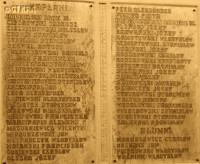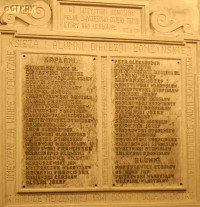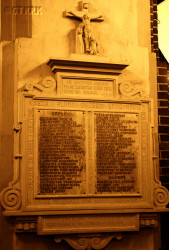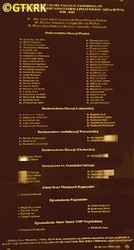Roman Catholic
St Sigismund parish
05-507 Słomczyn
85 Wiślana Str.
Konstancin deanery
Warsaw archdiocese, Poland
full list:
displayClick to display full list

searchClick to search full list by categories
wyświetlKliknij by wyświetlić pełną listę po polsku

szukajKliknij by przeszukać listę wg kategorii po polsku

Martyrology of the clergy — Poland
XX century (1914 – 1989)
personal data

surname
WĄDOŁOWSKI
forename(s)
Francis (pl. Franciszek)
function
diocesan priest
creed
Latin (Roman Catholic) Church RCmore on
en.wikipedia.org
[access: 2014.09.21]
diocese / province
Łomża diocesemore on
www.kuria.lomza.pl
[access: 2012.11.23]
Sejny diocesemore on
www.catholic-hierarchy.org
[access: 2021.12.19]
academic distinctions
Sacred Theology MA
honorary titles
prelate‐scholaster (Lat. praelati‐scholasticus)more on
en.wikipedia.org
[access: 2024.04.10]
(1926 – , St Michael the Archangel RC cathedral church, Łomżatoday: Łomża city pov., Podlaskie voiv., Poland
more on
en.wikipedia.org
[access: 2022.01.28])
honorary canonmore on
en.wikipedia.org
[access: 2014.11.14]
(1926 – , St Michael the Archangel RC cathedral church, Łomżatoday: Łomża city pov., Podlaskie voiv., Poland
more on
en.wikipedia.org
[access: 2022.01.28], Visitation of the Blessed Virgin Mary RC collegiate church, Sejnytoday: Sejny urban gm., Sejny pov., Podlaskie voiv., Poland
more on
en.wikipedia.org
[access: 2022.01.28])
date and place
of death
1940

Komornicki foresttoday: Działdowo gm., Działdowo pov., Warmia‐Masuria voiv., Poland
more on
en.wikipedia.org
[access: 2022.01.28]
alt. dates and places
of death
31.05.1940, 1943
KL Soldauconcentration camp
today: Działdowo, Działdowo urban gm., Działdowo pov., Warmia‐Masuria voiv., Poland
more on
en.wikipedia.org
[access: 2018.09.02]
KL Dachauconcentration camp
today: Dachau, Upper Bavaria reg., Bavaria state, Germany
more on
en.wikipedia.org
[access: 2016.05.30]
details of death
During Polish–Russian war of 1919‐1921 arrested in 1920 in Łomża, together with Bp Romuald Jałbrzykowski, by the attacking Russians. Repeatedly interrogated. Liberated on 18.08.1920, after Russian defeat in Warsaw battle of 08.1920 (known as the „Miracle on the Vistula”) and their panic retreat.
After German invasion of Poland on 01.09.1939 (Russians invaded Poland 17 days later) and start of the World War II, survived German aerial bombings of the town of Łomża. The Germans bombed civilian buildings, including the monastery of the Benedictine Nuns of Perpetual Adoration OSBap. During the bombing, Sister Hedwig Przestrzelska perished and he buried her.
Arrested by the Germans few days after fall of Łomża on 11‐12.09.1939 and start of German occupation, together with Fr Vladislav Kłapkowski, even before Łomża was handed over to the Russians, in fulfillment of the provisions of the Ribbentrop–Molotov Pact.
Held in the Springborn camp, organised by the Germans in the taken over Franciscan monastery in Stoczek Warmiński, in the then Germ. Provinz Ostpreußen (Eng. East Prussia Province).
From there prob. in 12.1939 transported to KL Hohenbruch concentration camp.
Finally on 17.03.1940 transported to KL Soldau concentration camp (then operated as DL Soldau, i.e. transit camp) where perished in unknown circumstances.
In the White Book it is assumed that was murdered in a nearby Komorniki forests in a mass execution during genocidal Germ. «Intelligenzaktion», extermination of Polish ruling classes and intelligentsia.
alt. details of death
According to others sources perished in KL Dachau concentration camp.
cause of death
extermination
perpetrators
Germans
sites and events
Komorniki forestsClick to display the description, KL SoldauClick to display the description, KL DachauClick to display the description, KL HohenbruchClick to display the description, SpringbornClick to display the description, «Intelligenzaktion»Click to display the description, Ribbentrop‐MolotovClick to display the description, Pius XI's encyclicalsClick to display the description, Polish‐Russian war of 1919‐1921Click to display the description
date and place
of birth
08.12.1880

Konopkitoday: Bakałarzewo gm., Suwałki pov., Podlaskie voiv., Poland
more on
en.wikipedia.org
[access: 2022.01.28]
parents
WĄDOŁOWSKI James
🞲 ?, ? — 🕆 ?, ?

PÓŁTORAK Rosalie
🞲 ?, ? — 🕆 ?, ?
baptism
11.12.1880

Bakałarzewotoday: Bakałarzewo gm., Suwałki pov., Podlaskie voiv., Poland
more on
en.wikipedia.org
[access: 2020.09.29]
St James the Apostle RC church
presbyter (holy orders)
ordination
15.04.1905

Sankt Petersburgtoday: Saint Petersburg city, Russia
more on
en.wikipedia.org
[access: 2020.07.31]
positions held
1925 – 1939
member of managment board — Łomżatoday: Łomża city pov., Podlaskie voiv., Poland
more on
en.wikipedia.org
[access: 2022.01.28] ⋄ Diocesan Curia — closest associate of Bp Stanislav Łukomski, deputy vicar general (c. 1929), vicar general (c. 1938), deputy vicar general (c. 1931‐1937), vicar general (c. 1929‐1930), official i.e. judicial vicar (c. 1925‐1929), advisor to the bishop for education and science (c. 1931‐1939), member of the Administrative Council (c. 1932‐1939), member of the Architectural Commission (c. 1932‐1935)
1926 – 1939
prelate‐scholaster (Lat. praelati‐scholasticus) — Łomżatoday: Łomża city pov., Podlaskie voiv., Poland
more on
en.wikipedia.org
[access: 2022.01.28] ⋄ Cathedral Chapter ⋄ St Michael the Archangel RC cathedral church — i.e. supervising Catholic education
1926 – 1939
pro‐synodal judge — Łomżatoday: Łomża city pov., Podlaskie voiv., Poland
more on
en.wikipedia.org
[access: 2022.01.28] ⋄ Bishop's Diocesan Court — also: pro‐synodal examiner
1921 – 1939
rector — Łomżatoday: Łomża city pov., Podlaskie voiv., Poland
more on
en.wikipedia.org
[access: 2022.01.28] ⋄ The Holy Trinity Abbey, Benedictine Nuns OSB ⋄ Holy Trinity RC church ⋄ Łomżatoday: Łomża city pov., Podlaskie voiv., Poland
more on
en.wikipedia.org
[access: 2022.01.28] RC deanery — also: chaplain of the convent chapel and confessor
c. 1922 – c. 1938
professor — Łomżatoday: Łomża city pov., Podlaskie voiv., Poland
more on
en.wikipedia.org
[access: 2022.01.28] ⋄ Theological Seminary — lecturer, among others in c. 1927‐1938 liturgy, c. 1928‐1929 music; also: prefect c. 1922‐1927 of the Mary Konopnicka's State Gymnasium No. 288 for Girls and in c. 1927 of the State School of Measurement and Industry and Forestry, head of the Kiliński's General University founded in 1919 on the initiative of the „Unitas” Association of Priests
c. 1912 – c. 1921
Lat. Promotor Fiscalis (Eng. Promoter of Justice) — Sejnytoday: Sejny urban gm., Sejny pov., Podlaskie voiv., Poland
more on
en.wikipedia.org
[access: 2022.01.28] ⋄ Diocesan Tribunal, Consistory (i.e. Curia)
1910 – 1921
professor — Sejnytoday: Sejny urban gm., Sejny pov., Podlaskie voiv., Poland
more on
en.wikipedia.org
[access: 2022.01.28] ⋄ Theological Seminary — also: prefect of elementary Polish schools, participant of the long–term battle for Polish education (e.g. high school), both during the Russian and German (after 1915) occupation, in Sejny
c. 1910 – c. 1914
vicar — Sejnytoday: Sejny urban gm., Sejny pov., Podlaskie voiv., Poland
more on
en.wikipedia.org
[access: 2022.01.28] ⋄ Visitation of the Blessed Virgin Mary RC cathedral church ⋄ Sejnytoday: Sejny urban gm., Sejny pov., Podlaskie voiv., Poland
more on
en.wikipedia.org
[access: 2022.01.28] RC deanery — also: director of cathedral choir
c. 1907 – c. 1909
prefect — Łomżatoday: Łomża city pov., Podlaskie voiv., Poland
more on
en.wikipedia.org
[access: 2022.01.28] ⋄ Private 7‐grade Commerce School for Men and Private 7‐grade Commerce School for Women ⋄ St Michael the Archangel RC parish ⋄ Łomżatoday: Łomża city pov., Podlaskie voiv., Poland
more on
en.wikipedia.org
[access: 2022.01.28] RC deanery
c. 1902 – c. 1906
student — Sankt Petersburgtoday: Saint Petersburg city, Russia
more on
en.wikipedia.org
[access: 2020.07.31] ⋄ philosophy and theology, Imperial Roman Catholic Spiritual Academy (1842‐1918) — postgraduate specialised studies crowned with a Sacred Theology Master's degree
till c. 1902
student — Sejnytoday: Sejny urban gm., Sejny pov., Podlaskie voiv., Poland
more on
en.wikipedia.org
[access: 2022.01.28] ⋄ philosophy and theology, Theological Seminary
others related
in death
PRZESTRZELSKAClick to display biography Hedwig (Sr Salesia), BIAŁYClick to display biography Vladislav, CIBOROWSKIClick to display biography Thaddeus, KŁAPKOWSKIClick to display biography Vladislav, KRYSIAKClick to display biography Andrew, KURACHClick to display biography Anthony, LATARSKIClick to display biography Joseph, ŁUKOMSKIClick to display biography Stanislav Kostka Andrew, MORAWSKIClick to display biography Michael, PAWLAKClick to display biography Anthony, ROGIŃSKIClick to display biography Joseph Stanislav, STEFAŃCZYKClick to display biography Faustinus, BAGDZIŃSKIClick to display biography Mieczyslav, CHWIŁOWICZClick to display biography Mieczyslav, JANKOWSKIClick to display biography Anthony, KEMPIŃSKIClick to display biography Stanislav, KLEPACZEWSKIClick to display biography Louis, KRYSIŃSKIClick to display biography John Julian, ŁADAClick to display biography Alex, MIASTKOWSKIClick to display biography Anthony, PIEŃKOWSKIClick to display biography Vladislav, PŁOSZAJClick to display biography Stanislav, RAMOTOWSKIClick to display biography Vladislav, ROSZKOWSKIClick to display biography Ceslav, SZCZEPANOWSKIClick to display biography Stanislav Felix, SZCZODROWSKIClick to display biography Marian, SZYMCZYKClick to display biography Joseph
sites and events
descriptions
Komorniki forests: Series of mass murders perpetrated by Germans at the bottom of Komorniki Hill, c. 6 km from Działdowo. Victims were Poles, representatives of Germ. Führungsschicht (Eng. Leading Classes), teachers, Catholic priests, office workers, farmers, political and social activists — prisoners of then DL Soldau Germ. „Durchgangslager für polnische Zivilgefangene” (Eng. „transit camp for Polish civilian POWs”). The first of the murders was prob. in 12.1939, on 34 teachers in Ciechanów county. Later prisoners transported from KL Hohenbruch, AbL Rudau, AbL AbL Groß‐Mischen, AbL Baydritten, Stalag I B Hohenstein camps in East Prussia, arrested earlier, were murdered. The victims were brought to the execution site — the trenches of 8 m × 6 m × 2 m were dug out earlier — in trucks and murdered from machine guns fire. Some individuals were executed in DL Soldau camp itself — in the basements of one of camp’s buildings. There they were killed with single shots to the head and bodies were subsequently buried in Komorniki forests. Altogether c. 1,500 people were murdered then, including c. 26. Catholic priests. (more on: pl.wikipedia.orgClick to attempt to display webpage
[access: 2020.07.31])
KL Soldau: German Germ. Konzentrationslager (Eng. concentration camp) KL Soldau (in modern Działdowo city) — since the pre‐war Polish Działdowo county was incorporated into Germ. Regierungsbezirk Allenstein (Eng. Olsztyn regency) the camp was located in occupied territories where general German law was in force, i.e. in Germany proper — was founded in 09.1939, when in former barracks of 32nd Infantry Regiment of Polish Army Germans set up a temporary camp for POW captured during September 1939 campaign. In autumn 1939 was also used as police jail. In 1939‐1940 changed into Germ. Durchgangslager für polnische Zivilgefangene (Eng. Transit Camp for Polish Civilians), prior to transport to other concentration camps. In reality it was used then as a place of extermination of Polish intelligentsia within Germ. «Intelligenzaktion» genocidal program and extermination of sick and disabled within «Aktion T4» program. Next in 05.1940 the camp was changed again into Germ. Arbeitserziehungslager (Eng. Work Education Camp), and finally into penal comp for criminal and political prisoners, most of whom were sentenced to death. In 1939‐1941 Germans imprisoned, maltreated and tortured in KL Soldau hundreds of Polish priests and religious. Approx. 80 priests, religious and nuns perished. They were murdered in the camp itself, by a shot into a head, or in places of mass executions in nearby forests — Białuty forest, Malinowo forets, Komorniki. Dates and precise locations of these murders remain unknown. Altogether in KL Soldau approx. 15,000 prisoners were murdered, including thousands victims — patients of psychiatric institutions (within «Aktion T4» plan). (more on: mazowsze.hist.plClick to attempt to display webpage
[access: 2013.08.17], en.wikipedia.orgClick to attempt to display webpage
[access: 2018.09.02])
KL Dachau: KL Dachau in German Bavaria, set up in 1933, became the main German Germ. Konzentrationslager (Eng. concentration camp) KL for Catholic priests and religious during World War II: On c. 09.11.1940, Reichsführer‐SS Heinrich Himmler, head of the SS, Gestapo and German police, as a result of the Vatican's intervention, decided to transfer all clergymen detained in various concentration camps to KL Dachau camp. The first major transports took place on 08.12.1940. In KL Dachau Germans held approx. 3,000 priests, including 1,800 Poles. The priests were forced to slave labor in the Germ. „Die Plantage” — the largest herb garden in Europe, managed by the genocidal SS, consisting of many greenhouses, laboratory buildings and arable land, where experiments with new natural medicines were conducted — for many hours, without breaks, without protective clothing, no food. They slaved in construction, e.g. of camp's crematorium. In the barracks ruled hunger, freezing cold in the winter and suffocating heat during the summer, especially acute in 1941‐1942. Prisoners suffered from bouts of illnesses, including tuberculosis. Many were victims of murderous „medical experiments” — in 11.1942 c. 20 were given phlegmon injections; in 07.1942 to 05.1944 c. 120 were used by for malaria experiments. More than 750 Polish clerics where murdered by the Germans, some brought to TA Hartheim euthanasia centre set up in Schloss Hartheim in Austria and murdered in gas chambers. At its peak KL Dachau concentration camps’ system had nearly 100 slave labour sub‐camps located throughout southern Germany and Austria. There were c. 32,000 documented deaths at the camp, and thousands perished without a trace. C. 10,000 of the 30,000 inmates were found sick at the time of liberation, on 29.04.1945, by the USA troops… (more on: www.kz-gedenkstaette-dachau.deClick to attempt to display webpage
[access: 2013.08.10], en.wikipedia.orgClick to attempt to display webpage
[access: 2016.05.30])
KL Hohenbruch: German Germ. Konzentrationslager (Eng. concentration camp) KL Hohenbruch and forced labour camp, mainly for Poles — e.g. captured during «Intelligenzaktion» — in operation in 1939‐1944/1945 in East Prussia, n. Konigsberg. Prisoners — a few thousands — slaved mainly at forest clearances and swamp draining. C. 200 perished murdered. (more on: pl.wikipedia.orgClick to attempt to display webpage
[access: 2013.08.17])
Springborn: In Franciscan monastery in Springborn (now: Stoczek Klasztorny) Germans interned and jailed many priests starting from 1938. In 1938 Austrian bishops were held captive there. In 1939, after German invasion of Poland, Polish priests from northern Poland were being held there prior to being sent to concentration camps. After 1945 commi‐nazi authorities held Polish Primate, cardinal Stephen Wyszyński in the monastery. (more on: pl.wikipedia.orgClick to attempt to display webpage
[access: 2015.05.09])
«Intelligenzaktion»: German: «Intelligenzaktion» (English: „Intelligence Action”) — a German program of extermination of the Polish elite, mainly the intelligentsia and leadership layers, carried out from the beginning of the occupation in w 09.1939 to 04.1940, mainly in territories directly annexed to Germany, but also in the so‐called Germ. Generalgouvernement (Eng. General Governorate), where it was called «AB‐aktion». In the first phase, immediately after the beginning of the German occupation, during military operations carried out by the Germ. Wehrmacht (Eng. Armed Forces) and the genocidal units of the Germ. Einsatzgruppen (Eng. Operational Groups) of the Germ. Sicherheitspolizei (Eng. Security Police), i.e. SiPo, and Germ. Sicherheitsdienst des Reichsführers SS (Eng. Security Service of the Reichsführer SS), i.e. SD, organized by the Germ. Reichssicherheitshauptamt (Eng. Reich Main Security Office), i.e. RSHA, which followed the troops, carried out under the Germ. Unternehmen „Tannenberg” (Eng. Operation „Tannenberg”) — based on the so‐called Germ. Sonderfahndungsliste (Eng. Special Wanted Lists), i.e. proscription lists of Poles considered particularly dangerous to the Third Reich, prepared by the Zentralstelle II/P (Polen) unit of the German RSHA. Later, implemented by the German civilian occupation authorities and the genocidal unit of the Germ. Volksdeutscher Selbstschutz (Eng. Ethnic Germans Self‐Defense), whose members were Germ. Volksdeutsche (Eng. Ethnic Germans), i.e. representatives of the German minority in Poland. According to various sources, these lists, at the beginning of 09.1939, could have contained the details of 61,000—88,000 „dangerous” Poles — although these figures cannot be confirmed. In total, during this genocide, c. 50,000 teachers, Catholic priests, representatives of the landed gentry, freelancers, social and political activists, and retired military personnel were systematically and methodically murdered. Another 50,000 were sent to concentration camps, where only a negligible percentage survived. (more on: en.wikipedia.orgClick to attempt to display webpage
[access: 2014.10.04])
Ribbentrop‐Molotov: Genocidal Russian‐German alliance pact between Russian leader Joseph Stalin and German leader Adolf Hitler signed on 23.08.1939 in Moscow by respective foreign ministers, Mr. Vyacheslav Molotov for Russia and Joachim von Ribbentrop for Germany. The pact sanctioned and was the direct cause of joint Russian and German invasion of Poland and the outbreak of the World War II in 09.1939. In a political sense, the pact was an attempt to restore the status quo ante before 1914, with one exception, namely the „commercial” exchange of the so‐called „Kingdom of Poland”, which in 1914 was part of the Russian Empire, fore Eastern Galicia (today's western Ukraine), in 1914 belonging to the Austro‐Hungarian Empire. Galicia, including Lviv, was to be taken over by the Russians, the „Kingdom of Poland” — under the name of the General Governorate — Germany. The resultant „war was one of the greatest calamities and dramas of humanity in history, for two atheistic and anti‐Christian ideologies — national and international socialism — rejected God and His fifth Decalogue commandment: Thou shall not kill!” (Abp Stanislav Gądecki, 01.09.2019). The decisions taken — backed up by the betrayal of the formal allies of Poland, France and Germany, which on 12.09.1939, at a joint conference in Abbeville, decided not to provide aid to attacked Poland and not to take military action against Germany (a clear breach of treaty obligations with Poland) — were on 28.09.1939 slightly altered and made more precise when a treaty on „German‐Russian boundaries and friendship” was agreed by the same murderous signatories. One of its findings was establishment of spheres of influence in Central and Eastern Europe and in consequence IV partition of Poland. In one of its secret annexes agreed, that: „the Signatories will not tolerate on its respective territories any Polish propaganda that affects the territory of the other Side. On their respective territories they will suppress all such propaganda and inform each other of the measures taken to accomplish it”. The agreements resulted in a series of meeting between two genocidal organization representing both sides — German Gestapo and Russian NKVD when coordination of efforts to exterminate Polish intelligentsia and Polish leading classes (in Germany called «Intelligenzaktion», in Russia took the form of Katyń massacres) where discussed. Resulted in deaths of hundreds of thousands of Polish intelligentsia, including thousands of priests presented here, and tens of millions of ordinary people,. The results of this Russian‐German pact lasted till 1989 and are still in evidence even today. (more on: en.wikipedia.orgClick to attempt to display webpage
[access: 2015.09.30])
Pius XI's encyclicals: Facing the creation of two totalitarian systems in Europe, which seemed to compete with each other, though there were more similarities than contradictions between them, Pope Pius XI issued in 03.1937 (within 5 days) two encyclicals. In the „Mit brennender Sorge” (Eng. „With Burning Concern”) published on 14.03.1938, condemned the national socialism prevailing in Germany. The Pope wrote: „Whoever, following the old Germanic‐pre‐Christian beliefs, puts various impersonal fate in the place of a personal God, denies the wisdom of God and Providence […], whoever exalts earthly values: race or nation, or state, or state system, representatives of state power or other fundamental values of human society, […] and makes them the highest standard of all values, including religious ones, and idolizes them, this one […] is far from true faith in God and from a worldview corresponding to such faith”. On 19.03.1937, published „Divini Redemptoris” (Eng. „Divine Redeemer”), in which criticized Russian communism, dialectical materialism and the class struggle theory. The Pope wrote: „Communism deprives man of freedom, and therefore the spiritual basis of all life norms. It deprives the human person of all his dignity and any moral support with which he could resist the onslaught of blind passions […] This is the new gospel that Bolshevik and godless communism preaches as a message of salvation and redemption of humanity”… Pius XI demanded that the established human law be subjected to the natural law of God , recommended the implementation of the ideal of a Christian state and society, and called on Catholics to resist. Two years later, National Socialist Germany and Communist Russia came together and started World War II. (more on: www.vatican.vaClick to attempt to display webpage
[access: 2023.05.28], www.vatican.vaClick to attempt to display webpage
[access: 2023.05.28])
Polish‐Russian war of 1919‐1921: War for independence of Poland and its borders. Poland regained independence in 1918 but had to fight for its borders with former imperial powers, in particular Russia. Russia planned to incite Bolshevik‐like revolutions in the Western Europe and thus invaded Poland. Russian invaders were defeated in 08.1920 in a battle called Warsaw battle („Vistula river miracle”, one of the 10 most important battles in history, according to some historians). Thanks to this victory Poland recaptured part of the lands lost during partitions of Poland in XVIII century, and Europe was saved from the genocidal Communism. (more on: en.wikipedia.orgClick to attempt to display webpage
[access: 2014.12.20])
sources
personal:
mazowsze.hist.plClick to attempt to display webpage
[access: 2014.11.02], lomzynskie24.plClick to attempt to display webpage
[access: 2016.03.14], zaginieni1939-45.plClick to attempt to display webpage
[access: 2013.12.04], search.jzi.org.plClick to attempt to display webpage
[access: 2025.08.19]
bibliographical:
„Fate of the Catholic clergy in USSR 1917‐1939. Martyrology”, Roman Dzwonkowski, SAC, ed. Science Society KUL, 2003, Lublin
original images:
radioolsztyn.plClick to attempt to display webpage
[access: 2021.08.06]
LETTER to CUSTODIAN/ADMINISTRATOR
If you have an Email client on your communicator/computer — such as Mozilla Thunderbird, Windows Mail or Microsoft Outlook, described at WikipediaPatrz:
en.wikipedia.org, among others — try the link below, please:
LETTER to CUSTODIAN/ADMINISTRATORClick and try to call your own Email client
If however you do not run such a client or the above link is not active please send an email to the Custodian/Administrator using your account — in your customary email/correspondence engine — at the following address:

giving the following as the subject:
MARTYROLOGY: WĄDOŁOWSKI Francis
To return to the biography press below:
 Click to return to biography
Click to return to biography











